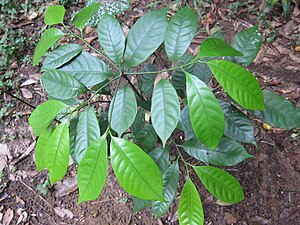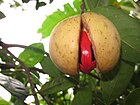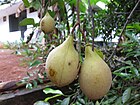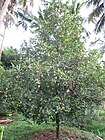Note: This is a project under development. The articles on this wiki are just being initiated and broadly incomplete. You can Help creating new pages.
Myristica fragrans - Mayaphala
Quercus infectoria is a species of oak, bearing galls that have been traditionally used for centuries in Asia medicinally. Quercus infectoria or locally known as Manjakani in Malaysia
Contents
- 1 Uses
- 2 Parts Used
- 3 Chemical Composition
- 4 Common names
- 5 Properties
- 6 Habit
- 7 Identification
- 8 List of Ayurvedic medicine in which the herb is used
- 9 Where to get the saplings
- 10 Mode of Propagation
- 11 How to plant/cultivate
- 12 Commonly seen growing in areas
- 13 Photo Gallery
- 14 References
- 15 External Links
Uses
Bleeding piles, Rectal bleeding, Irritable bowel syndrome, Liver disorders, Rectal prolapse, Uterine prolapse, Leucorrhea, Vaginitis, Toothache
Parts Used
Chemical Composition
Gallic Acid & Tannic Acid are found in Manjakani[1]
Common names
| Language | Common name |
|---|---|
| Kannada | Machikaai, Mapalakam |
| Hindi | Maajoophal, Majuphal |
| Malayalam | Majakaanee, Mashikkay |
| Tamil | Machakaai, Masikki |
| Telugu | Machikaaya |
| Marathi | NA |
| Gujarathi | NA |
| Punjabi | NA |
| Kashmiri | NA |
| Sanskrit | Mayaphala, Majuphul |
| English | Oak Galls, Magic Nuts |
Properties
Reference: Dravya - Substance, Rasa - Taste, Guna - Qualities, Veerya - Potency, Vipaka - Post-digesion effect, Karma - Pharmacological activity, Prabhava - Therepeutics.
Dravya
Rasa
Kashaya (Astringent)
Guna
Laghu (Light), Ruksha (Dry)
Veerya
Sheeta (cold)
Vipaka
Katu (Pungent)
Karma
Kapha, Pitta
Prabhava
Habit
Identification
Leaf
| Kind | Shape | Feature |
|---|---|---|
| Simple | alternate | The leaves are divided into 3-6 toothed leaflets, with smaller leaflets in between |
Flower
| Type | Size | Color and composition | Stamen | More information |
|---|---|---|---|---|
| Unisexual | 2-4cm long | Yellow | 5-20 | Flowers Season is June - August |
Fruit
| Type | Size | Mass | Appearance | Seeds | More information |
|---|---|---|---|---|---|
| simple | 7–10 mm | clearly grooved lengthwise, Lowest hooked hairs aligned towards crown | many | {{{6}}} |
Other features
List of Ayurvedic medicine in which the herb is used
Where to get the saplings
Mode of Propagation
How to plant/cultivate
Seed - best sown when fresh. Germination usually takes place in 5 - 6 weeks. Seed in the shell takes some 4 - 6 weeks to germinate; without the shell it may germinate in half that time. The seed can take up to 30 months to germinate. Cuttings of half-ripe wood. Air layering. After about 3 - 5 months, the rooted watershoot is cut off and planted in a nursery. After a period of growth it is hardened off and planted in the field. This method succeeds in 60-70% of cases [4]
Commonly seen growing in areas
Evergreen forest, Western ghats
Photo Gallery
References
External Links
- Ayurvedic Herbs known to be helpful to treat Bleeding piles
- Ayurvedic Herbs known to be helpful to treat Rectal bleeding
- Ayurvedic Herbs known to be helpful to treat Irritable bowel syndrome
- Ayurvedic Herbs known to be helpful to treat Liver disorders
- Ayurvedic Herbs known to be helpful to treat Rectal prolapse
- Ayurvedic Herbs known to be helpful to treat Uterine prolapse
- Ayurvedic Herbs known to be helpful to treat Leucorrhea
- Ayurvedic Herbs known to be helpful to treat Vaginitis
- Ayurvedic Herbs known to be helpful to treat Toothache
- Herbs with Leaves used in medicine
- Herbs with common name in Kannada
- Herbs with common name in Hindi
- Herbs with common name in Malayalam
- Herbs with common name in Tamil
- Herbs with common name in Telugu
- Herbs with common name in Sanskrit
- Herbs with common name in English
- Habit - Shrub
- Index of Plants which can be propagated by Seeds
- Index of Plants which can be propagated by Cuttings
- Herbs that are commonly seen in the region of Evergreen forest
- Herbs that are commonly seen in the region of Western ghats
- Herbs
- Myristicaceae








